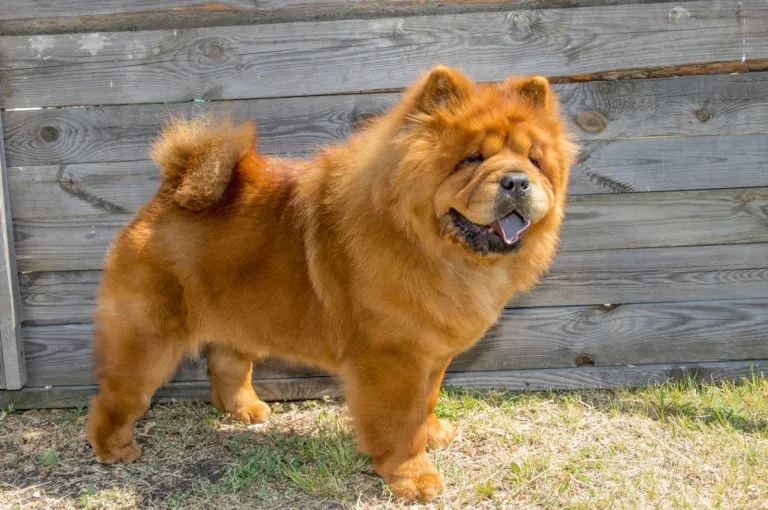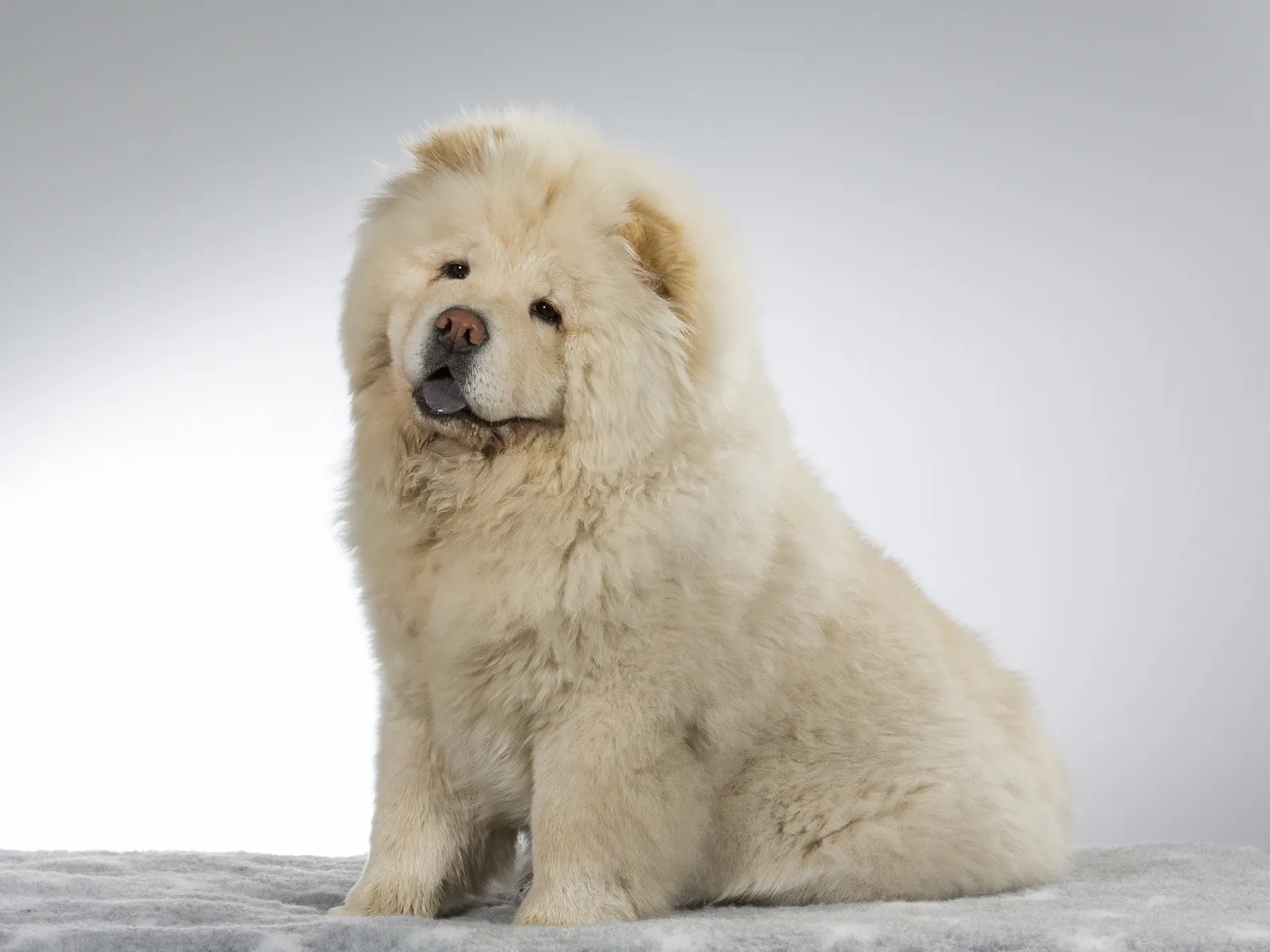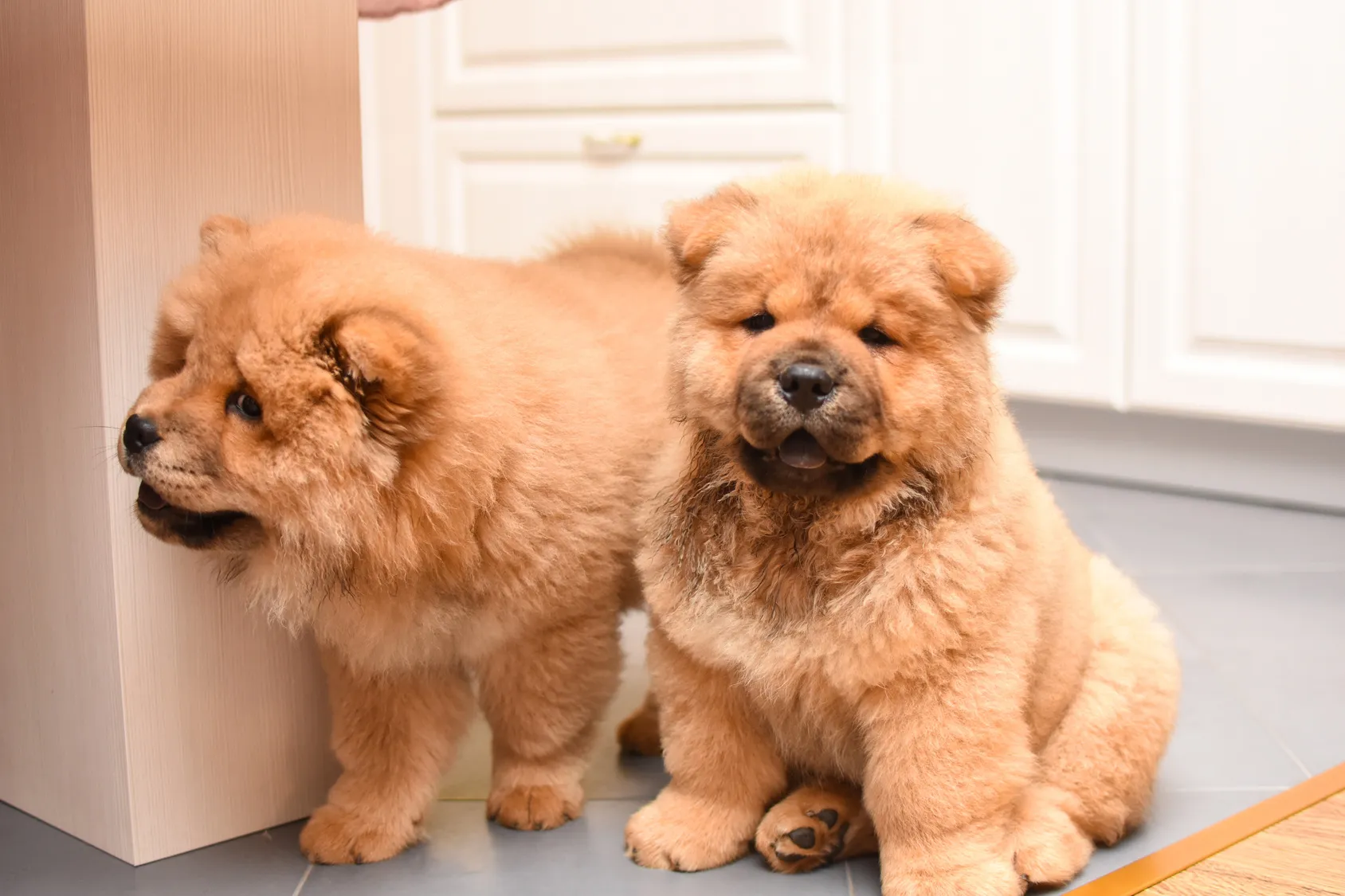Beagle
The Beagle's short legs can be deceiving – this medium-sized dog keeps you on your toes and is always full of surprises! This friendly breed is active, fearless and extremely clever.
Golden-brown fur and a mighty mane, with a compact build – the Chow-Chow makes a distinct impression with its majestic appearance. But the original dog breed, which is one of the oldest in the world, is not only gorgeous, it also has a very special character: some say that chow-chows have the essence of a cat rather than that of a dog because of their individuality. Anyone who has made friends with a chow-chow knows that the dogs have not only the looks but also the heart of a lion.

© ALIAKSEI / stock.adobe.com
In China, the breed is also referred to as a “fluffy lionhound”, “bear dog” or “blue tongue” – names which already hint at the dog‘s striking appearance. The Chow-Chow belongs to the Asian Spitz group. It has a compact stature and weighs max. 30kg at a maximum height of 56cm at the shoulder. There are both short and long-hair Chow-Chows and the short-haired specimens also have very plush, soft fur. The short-haired “smooth chows” are far less common than the long-haired version. These in turn have a dense undercoat and a lush “mane” – the lion look that is typical of the Chow-Chow. Their imposing fur is always monochrome, but the belly side as well as the inner thighs may be brighter. The breed colors are black, red, blue, fawn, cream and white. The thick little ears stand upright and the tail curves over the back.
A particular characteristic of the Chow-Chow is revealed when it opens its mouth: its tongue, gums and palate are blue. What would be a worrying sign in other breeds – blue tongue and gums can point to lack of oxygen – is a part of the breed standard for the Chow-Chow, rather than a sign of illness. There is no clear scientific expanation for the colouring, however legends abound around the origins of the blue tongue. One story tells it that when the world and the heavens were created, parts of the dark blue firmament crumbled away and fell to the ground and only the Chow-Chow was permitted to lick them up. Slightly less far-fetched ideas point to a connection with the circulation or temperature balance of these dogs.
 © Jne Valokuvaus / stock.adobe.com
© Jne Valokuvaus / stock.adobe.com
The breed comes from China, but has Siberian ancestry. This type of dog is over a thousand years old, which means that Chow-Chows belong to the ancient breeds; genetically very different from most dog breeds today. It is thought that the Chow-Chow also influenced the depiction of the “Fu-dogs”, which are guardians in front of many typical Chinese buildings – similar to the lion statues in Europe. In the ancient world, chow-chows were actually used as temple guardians in China, Mongolia and Tibet. Later, when they became more widespread, they were increasingly used as a hunting dog or private guard dog, becoming more and more a dog of the people. Nevertheless, a few examples of this conspicuous breed served as a status symbol for the Emperor’s court for a long time. However, many chow-chows may have ended up as dinner for the people who bred them, as they also prized the warming fur. In the 19th century the breed came to Europe. In the UK, the first chow chows were not found in people’s living-rooms, but in the zoo, where they attracted great interest from visitors. In 1865, Queen Victoria received one of the striking dogs from China as a gift, which awakened the desire for the “lion dogs” as pets in society. In 1895, the first Chow-Chow enthusiasts founded a society in the UK, and the “Chow Chow Club” was founded in the USA 10 years later, but the plush dogs remained unattainable for most people in the West and were long regarded as a status symbol. There have been representatives of the breed in the White House: US President Calvin Coolidge (1923-1929) had two Chow-Chows named Tiny Tim and Blackberry.
Nowadays there are hardly any Chow-Chows left in China, but many to be found in Europe and North America, where the breed was one of the most popular around during the 1980s.
Another thing that is unclear in the heritage of the Chow-Chow breed is how it came by its name. There are a number of theories, one of which is that the name is comes from the Chinese word for dog, Gou. Others believe that it comes from pidgin-English, where chow-chow has more to do with eating – Americans still sometimes refer to food as chow. It could be said that this name still hints at the fact that the breed’s ancient (and thankfully long since banned) use was for its meat.
Some say that Chow-Chow’s are more like cats than dogs. You can be their owner, but you don’t own them!
They do not have a pronounced will to please and are hardly submissive, instead they have a certain stubborn streak. With strangers and other dogs, they are usually rather reserved, unless they are in their territory – then the chow-chow can turn decidedly unfriendly. Their basic distrust of strangers and their territorial behavior make chow-chows good guard dogs. However, when encountering other dogs, they may find it difficult to control aggression if they have not been properly trained. In particular, they can react badly to dogs of the same sex, especially if they are other chow-chows. Caution is also needed when you meet smaller dogs, as they can arouse the chow chow’s hunting instinct. All of this means that it is vital that young dogs of this breed are socialised early. Overall, the Chow-Chow is a good-natured dog that is otherwise calm and serene. It is not always possible to allow Chow-Chows off the lead due to their strong hunting instinct and the fact that they are not always guaranteed to come back when you call them.
The Chow-Chow has a tendency to suffer from skin complaints and eczema, turned-in eyelids as well as dysplasia of the elbows and hips. Regular preventive examinations and appropriate treatment can often slow the course of these complaints so that operations are not necessary. Due to their genetic disposition to certain ailments, it is particularly advisable to ensure parent animals have been suitably tested when buying puppies: Serious breeders only use healthy animals for their breeding. A sad story recently appeared in the news of Todd, a Chow-Chow pup belonging to Justin Bieber, who gave the puppy to one of his dancers when it reached late puppyhood. The dancer then had to ask for donations for the approximately 8,000 US dollars that it cost for hip surgery for the seven month-old dog. Chow-Chows can live to reach 12 to 14 years of age, on average.
 © Ivan / stock.adobe.com
© Ivan / stock.adobe.com
The lion’s mane needs some serious TLC! If you own a long-hair Chow-Chow, you need to be prepared to groom them 2-3 times per week, if not every day. They need to be thoroughly combed once per week, with additional (less intensive) brushing every day in between. Behind the ears and the neck crease are the areas where their fur tends to get matted, but you should avoid giving them baths, unless they are really so dirty that the hair can’t be combed out. A few Chow-Chow breeders recommend a monthly bath, but if you decide to bath your pet you should try to use natural cleaning products, including a mild dog shampoo, possibly with camomile, to reduce the danger of allergic reaction for irritation. In the warmer months, pay particular attention to the area where the dog’s tail meets its body, as this is where skin irritation can occur. The shorthair Chow-Chow needs a lot less grooming.
The Chow-Chow’s stubbornness means that it is a difficult dog to train. It needs clear and consistent commands – every time you gaze into the puppy dog eyes and give in to him, you are storing up trouble for later on, because the Chow-Chow will always try to get its own way. You can attempt to train a Chow-Chow using loving consistency and empathy, but it will never willingly listen to you. Rather, it will tend to go with its own ideas. Ideally, you should seek out a dog training school that already has experience with the breed before your Chow-Chow comes home. Dog training school is also a good place for your puppy to learn to socialise with other dogs, which is very important with this breed. The nature of the Chow-Chow means that it really needs an experienced dog owner, who will not make the typical mistakes that beginners tend to make when first training a new dog. You want to avoid the chance of getting into situations where you are unable to control your dog. If you have little experience with dogs, you should definitely read up on dog training and get tips from experienced Chow-Chow owners or a breeder.
Agility, dog dancing, jogging? None of these activities are the kind of thing that your Chow-Chow will be into. They are far too laid-back and their dense fur and steep hindquarters mean that they are not built for endurance. They appreciate long walks with lots of opportunities to sniff around, but they do not need owners that are too sporty. They don’t need long hikes. The long-haired Chow-Chow does not tolerate the heat well, so exertion in the summer months is a no-no.
Few people consider the Chow-Chow to be a family dog, although there are some exceptions to the rule. If you have your heart set on this little lion, you should seriously consider whether the breed’s temperament is really suited to your situation. Chow-Chows form a close bond with their owners which means that they are fine to be kept without other canine companions. Before you buy, you also need to consider whether you have time for the coat care required for the breed, especially for long-haired chow-chows. Chow-Chows enjoy being in the outdoors, so they can be kept in a securely fenced garden or indoors with the family. As they have a comparatively long lifespan, you need to consider whether you are happy to look after the dog for over 10 years, 365 days a year, including holidays. If you need to leave your dog with a relative or in kennels whilst you are on holiday or away on business, will they be able to care for the dog’s coat adequately? Given the amount of shedding and coat care required, you also need to make sure that nobody in your household is allergic to dog hair before you agree to buy one of these beautiful dogs. Veterinary care for this breed can also be very expensive, and that comes on top of the usual dog paraphernalia that you will need, such as a dog bed, lead, collar, brushes and combs, bowls and car safety equipment. You need to take particular care if you already have other pets in your household, especially if you have a cat. Always choose a young dog that has already been socialised with cats, for example in the breeder’s home. Older Chow-Chows that are not used to cats often view them as prey. A Chow-Chow can be a good companion for older children, so long as you set clear rules beforehand that the children need to behave consistently and always treat the dog with respect. If you can trust your children to behave well, then nothing else should stand in the way of friendship.
Chow-Chows are not a common dog breed, but there are serious breeders out there if you look for them through a breed association listing. A reputable breeder will be an expert on the breed, and have all of the necessary paperwork for each of his or her animals. The right breeder will value the health and wellbeing of their animals far more highly than the money that they earn from them and will be more than happy to allow you to visit and inspect puppies and parent animals alike. Any good breeder will usually be more than happy to answer any questions that you have about the breed. When you take your puppy home, you should also be handed its official breed papers as well as any health records (immunisations, etc.) and chip information. Before a breeder hands a puppy over to your care, they will also want to make sure that you are the right person to take care of the pup, so be prepared to answer (honestly!) questions about your home, household and lifestyle, as well as around your experience with dogs. Take care when choosing a breeder and do not buy from puppy farms or unregistered so-called purebreed puppy breeders. Buying from unscrupulous breeders, even if you feel sorry for the animals, just encourages them to continue to profit from their animals, without providing them with the care and love that they deserve. You also risk buying a puppy with a hidden genetic condition or illness, which can be costly for you in terms of vet’s bills, and lead to unnecessary suffering for the animal.
If you consider buying an older Chow-Chow, you can try looking on the internet for animals that need to be rehomed. You may also find a cross-breed that resembles a Chow-Chow.
The Beagle's short legs can be deceiving – this medium-sized dog keeps you on your toes and is always full of surprises! This friendly breed is active, fearless and extremely clever.
The Golden Retriever is still one of the most popular dog breeds, especially with families. It is defined not just by its docility, but shows numerous other qualities too. Read in the following article everything you need to know about the Golden Retriever.
The German Shepherd is one of the most popular utility dog breeds in the world, though the willing-to-learn and people-focused nature of these versatile dogs also makes them suitable for family life.